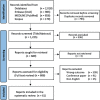Frequency of Publication of Dermoscopic Images in Inter-observer Studies: A Systematic Review
- PMID: 34853864
- PMCID: PMC9472090
- DOI: 10.2340/actadv.v101.865
Frequency of Publication of Dermoscopic Images in Inter-observer Studies: A Systematic Review
Abstract
Research interest in dermoscopy is increasing, but the complete dermoscopic image sets used in inter-observer studies of skin tumours are not often shared in research publications. The aim of this systematic review was to analyse what proportion of images depicting skin tumours are published in studies investigating inter-observer variations in the assessment of dermoscopic features and/or patterns. Embase, MEDLINE and Scopus databases were screened for eligible studies published from inception to 2 July 2020. For included studies the proportion of lesion images presented in the papers and/or supplements was extracted. A total of 61 studies (53 original studies and 8 shorter reports (i.e. research letters or concise reports)). published in the period 1997 to 2020 were included. These studies combined included 14,124 skin tumours, of which 373 (3%) images were published. This systematic review highlights that the vast majority of images included in dermoscopy research are not published. Data sharing should be a requirement for future studies, and must be enabled and standardized by the dermatology research community and editorial offices.
Conflict of interest statement
Figures
Similar articles
-
Dermoscopy Proficiency Expectations for US Dermatology Resident Physicians: Results of a Modified Delphi Survey of Pigmented Lesion Experts.JAMA Dermatol. 2021 Feb 1;157(2):189-197. doi: 10.1001/jamadermatol.2020.5213. JAMA Dermatol. 2021. PMID: 33404623 Free PMC article.
-
Assessment of Diagnostic Accuracy of Dermoscopic Structures and Patterns Used in Melanoma Detection: A Systematic Review and Meta-analysis.JAMA Dermatol. 2021 Sep 1;157(9):1078-1088. doi: 10.1001/jamadermatol.2021.2845. JAMA Dermatol. 2021. PMID: 34347005 Free PMC article.
-
Standardization of dermoscopic terminology and basic dermoscopic parameters to evaluate in general dermatology (non-neoplastic dermatoses): an expert consensus on behalf of the International Dermoscopy Society.Br J Dermatol. 2020 Feb;182(2):454-467. doi: 10.1111/bjd.18125. Epub 2019 Jul 28. Br J Dermatol. 2020. PMID: 31077336
-
Reliability and inter-observer agreement of dermoscopic diagnosis of melanoma and melanocytic naevi. Dermoscopy Panel.Eur J Cancer Prev. 1998 Oct;7(5):397-402. doi: 10.1097/00008469-199810000-00005. Eur J Cancer Prev. 1998. PMID: 9884886
-
Dermoscopic Features of Giant Molluscum Contagiosum in a Patient with Acquired Immunodeficiency Syndrome.Acta Dermatovenerol Croat. 2020 Dec;28(7):233-235. Acta Dermatovenerol Croat. 2020. PMID: 33834996
References
-
- Braun RP, Rabinovitz HS, Oliviero M, Kopf AW, Saurat JH. Dermoscopy of pigmented skin lesions. J Am Acad Dermatol 2005; 52: 109–121. - PubMed
-
- Engasser HC, Warshaw EM. Dermatoscopy use by US dermatologists: a cross-sectional survey. J Am Acad Dermatol 2010; 63: 412–419, 419 e411–412. - PubMed
-
- Argenziano G, Soyer HP, Chimenti S, Talamini R, Corona R, Sera F, et al. . Dermoscopy of pigmented skin lesions: results of a consensus meeting via the Internet. J Am Acad Dermatol 2003; 48: 679–693. - PubMed
-
- Taichman DB, Backus J, Baethge C, Bauchner H, de Leeuw PW, Drazen JM, et al. . Sharing clinical trial data – a proposal from the International Committee of Medical Journal Editors. N Engl J Med 2016; 374: 384–386. - PubMed
LinkOut - more resources
Full Text Sources



